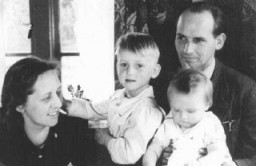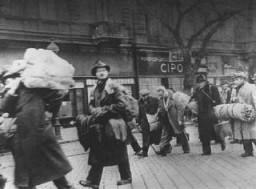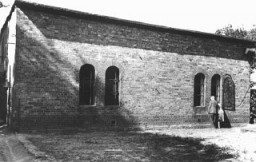
Non-Jewish Resistance
Between 1933 and 1945, a variety of groups offered resistance to the Nazi regime, both in Germany and in German-occupied territory.
Resistance within Germany
Among the earliest domestic opponents of Nazism were Communists, Socialists, and trade union leaders.
Although mainstream church hierarchies either supported the Nazi regime or acquiesced in its policies of discrimination and persecution, individual German theologians such as Dietrich Bonhoeffer opposed the regime. Bonhoeffer, who was connected to anti-Hitler military officers in the German Armed Forces intelligence service (Abwehr), was arrested in 1943 and executed in 1945.
Within the German conservative elite and the German General Staff, small pockets of opponents to the Nazi regime existed. In July 1944, under the leadership of Colonel Klaus Schenk Graf von Stauffenberg, a coalition of these groups and a handful of moderate Social Democratic politicians conspired unsuccessfully to assassinate Adolf Hitler and overthrow the Nazi regime.
Another small resistance group in Germany developed around the Munich students Hans and Sophie Scholl. The group was known as the White Rose. Through a leaflet campaign, they sought to directly expose the atrocities committed by German forces in the east and to urge Germans to actively oppose the Nazi regime. Arrested by the Gestapo (German secret state police) in February 1943, the Scholls and several other members of their group were executed.
Resistance in German-Occupied Europe
Resistance occurred in German-occupied Europe as well. In France, General Charles de Gaulle refused to swear allegiance to the Vichy Regime. He organized a Provisional National Committee of the Free French based in London and advocated open resistance against the collaborationist Vichy regime.
On French soil, both a Gaullist resistance movement and a communist resistance movement developed in 1941 and committed acts of sabotage and assaults on German officials.
After the German occupation of Denmark in April 1940, a resistance movement began operations there; its activities included killing informers, raiding German military facilities, and sabotaging rail lines. Likewise a Norwegian resistance developed; one of its most spectacular feats was the destruction of the Norwegian heavy water supply at Norsk Hydro Electric Company in Vemock in late February 1943.
In February 1941 the Dutch population, led by resistance leaders in the trade union organizations, mounted a general strike in protest of arrests and brutal treatment of Jews. After the Germans occupied Italy in September 1943, following Italy's unconditional surrender to the Allies, serious partisan resistance, both Communist and non-Communist, harassed the German authorities, particularly in northeastern Italy.
In the Soviet Union, Slovakia, Yugoslavia, Greece, and Poland, guerrilla fighters, called partisans, offered armed resistance and engaged in sabotage, insurgency, and outright attacks and assassinations of German occupation personnel and their Slovak and Croat allies.
In August 1944, the Polish (non-communist) Home Army rose against the German occupation forces in Warsaw in anticipation of an imminent Soviet attack across the Vistula into the center of the city. Though the Soviets did not move forward, the Home Army fought for two months in the ruins of Warsaw before surrendering to the Germans. Insurgents of the communist People's Army were also active in sabotage and assaults on German personnel in occupied Poland.
Also in August 1944, Slovak underground leaders—communist and non-communist—launched an uprising (the Slovak national uprising) against the pro-German Tiso government. It took two months for Germans and the fascist Hlinka Guard militia to quell the uprising.
In partitioned Yugoslavia, partisan resistance developed among the Slovenes in German-annexed Slovenia, engaging mostly in small-scale sabotage. In Serbia, a cetnik resistance organization developed under a former Yugoslav Army Colonel, Draža Mihailovic. After a disastrous defeat in an uprising in June 1941, this organization tended to withdraw from confrontation with the Axis occupying forces. The communist-dominated Partisan organization under the leadership of Josef Tito was a multi-ethnic resistance force—including Serbs, Croats, Bosniaks (Serbo-Croatian speaking Muslims), Jews, and Slovenes. Based primarily in Bosnia and northwestern Serbia, Tito's Partisans fought the Germans and Italians most consistently and played a major role in driving the German forces out of Yugoslavia in 1945.
In May 1942, Czech agents, parachuted into Bohemia by the British at the request of the Czechoslovak government-in-exile in London, and launched an assassination attempt on SS General Reinhard Heydrich in Prague. There, Heydrich had served, in addition to his other duties, as Reich Protector of Bohemia and Moravia. Heydrich was the chief of the Reich Main Office for Security and the architect of the plan for the "Final Solution" of the Jewish question. In retaliation, German SS and police shot all of the men and deported the women and children from the villages of Lidice and Ležáky.
Resistance by Members of Victimized Groups
Members of other victimized groups resisted the Nazis. In May 1944, SS men ordered Roma (Gypsies) to leave their barracks at the Auschwitz Gypsy family camp (presumably to be sent to the gas chambers). Armed with knives and axes, the Roma refused to leave. The SS men retreated.
Jehovah's Witnesses resisted Nazism through defiance. They refused to serve in the German army and, as concentration camp prisoners, organized illegal study groups.
Non-Violent Resistance
Forms of non-violent resistance included sheltering Jews, listening to forbidden Allied radio broadcasts, and producing clandestine anti-Nazi newspapers.
Individuals Acting Alone
On occasion, lone individuals without connections resisted. One of the most spectacular incidents of individual resistance was the effort of a carpenter named Georg Elser to assassinate Hitler in November 1939 by planting a bomb in a pillar in the Bürgerbräu beer cellar, where the dictator spoke every year in commemoration of the 1923 Beer Hall putsch. Elser's plan was foiled by the unexpected early departure of Hitler for the western front; the dictator left the hall before the bomb was timed to go off. Elser was caught trying to cross the Swiss border and held in a concentration camp in an isolated cell until the Gestapo secretly killed him in April 1945.
Series: Rescue and Resistance during the Holocaust
Critical Thinking Questions
- There are many types of resistance besides active or armed resistance. What obstacles may block individuals from resisting in these other ways?
- How did the risks of resistance to the Nazis differ from country to country and/or as the war proceeded? How is timing important in the effort to overthrow an oppressive regime?









